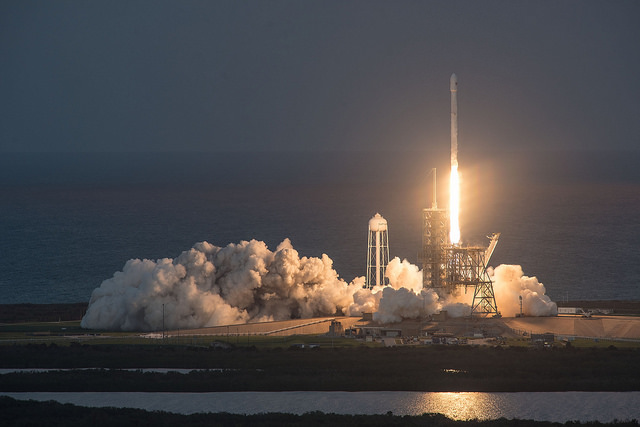
One article pondering how the planned super-heavy lift rocket from SpaceX will open up space travel like the DC-3 did for air travel. The third reuse of a Falcon 9 booster and the 18th recovery of a booster. Also, three articles on SpaceX’s plans for Mars colonization:
- 9/29/17 – Wall Street Journal – Elon Musk Projects First Private Trips to Mars by Middle of Decade
- 9/29/17 – Behind the Black – Elon Musk’s economic version of SLS
- 9/29/17 – NASA Spaceflight – Moon, Mars, & around the earth – Musk updates BFR architecture, plans
In a major speech, Mr. Musk revealed the revised plans for SpaceX’s journey to Mars. The revision I see is a slightly scaled-down interplanetary spacecraft which can be multipurposed for lunar activity, resupplying ISS, or any other mission requiring heavy lift.
The vehicle will have 31 engines instead of the 47 planned a year ago. It will still lift 150 tons into low earth orbit.
Key concepts will be reusability of lift vehicles and in-orbit refueling to get vehicles ready for the interplanetary trip. Concept will be capsules can land vertically and will be able to take off without crew input.
Interplanetary capsule will be designed to have 100 person capacity and will have areas on board for entertainment.
The first trips to Mars could be in 2022 or more likely delayed until 2024. That is only 5 or 7 years from now.
Outlines of the Mars colonization plan are in line with what I’ve read before.
The first two missions, presumably in 2022, will be scouting missions to test locations for presence of elements needed to create fuel, and assess other risks. The next four missions will consist of two ships with supplies and equipments and two ships with crews. First step on Mars would be to start functioning and then set up a production plant to manufacture water, oxygen, and propellant for a return trip. The load for a return trip is targeted to be in the range from 20 up to 50 tons.
Oh, as merely one more indication of the coarsening of our culture, the name of the heavy lift vehicle is BFR, with the middle letter being a very naughty word.
9/30/17 – Brian Wang at Next Big Future – SpaceX Big Rocket will go down in history like DC-3 and Caravel sailing ships – The BFR from SpaceX will be the step that widely opens up space, according to the article. One BFR launch could place in orbit a space station 2 or 4 times larger than the current ISS, which took dozens of trips (plural dozens!) by the Space Shuttle.
A few launches could carry a few thousand sats to create an entire constellation of LEO comm satellites. Article guesses one constellation could generate up to thirty billion a year of revenue.
A BRF could refuel in orbit, then go to the moon and back, returning to a concrete landing pad.
First analogy is how the DC-3 revolutionized air travel.
Second analogy is the Caravel sailing ship, which revolutionized exploring in the sailing age. It was easier to navigate and maneuver than the previous ships. The new sail allowed it to go further from shore and even sail into the wind (I sure don’t understand how that works). Christopher Columbus used three caravel ships for his explorations. The Portuguese and Spanish traders used caravels to trade with the world.
Author thinks that if SpaceX can successfully build and deploy a fleet of BFRs, it will open up space travel more than the DC-3 and caravel ships combined opened travel in the past.
10/11/17 – Space.com – That Makes Three: SpaceX Launches Another Satellite with a Used Rocket, Then Lands – Successful launch of the EcoStar 105/SES-11 com sat and recovery of the Falcon 9 booster marks the third reuse and recovery of a booster. Three reuses.
This is the 18th successful recovery of a booster.
SpaceX has also reused a Dragon capsule.
This was also the second SpaceX launch in three days. In addition, this is the second time they have launched twice in that fast a time frame.
All aspects of this mission are amazing: the recovery of a booster, the booster having already been used, and a two-in-three-days launch rate. All are pointing toward establishing those factors as routine.